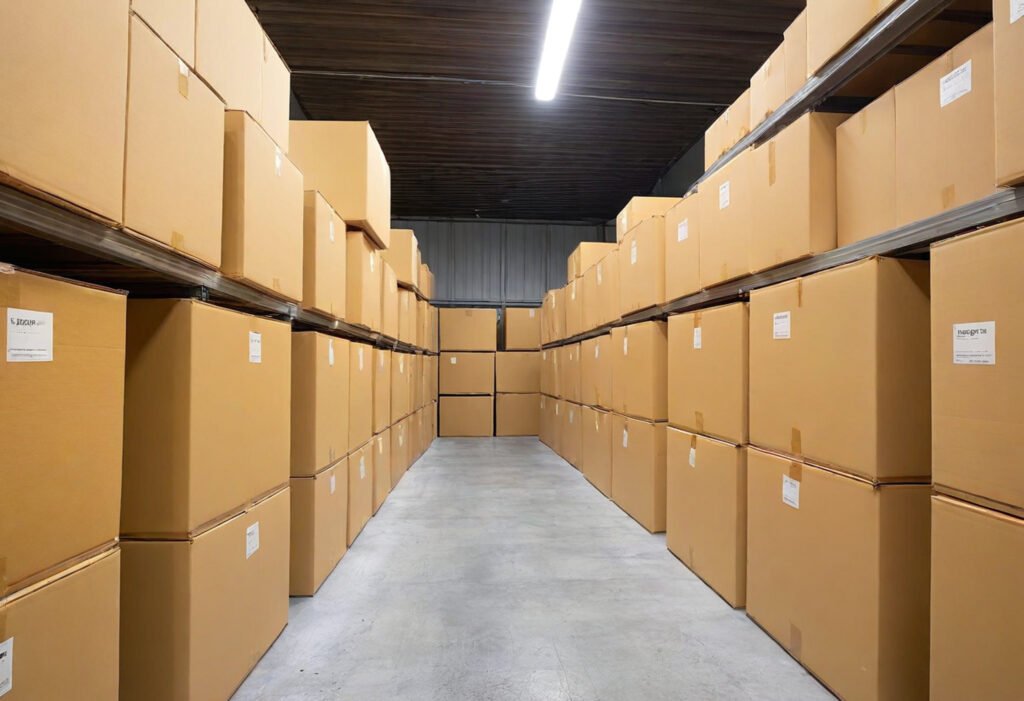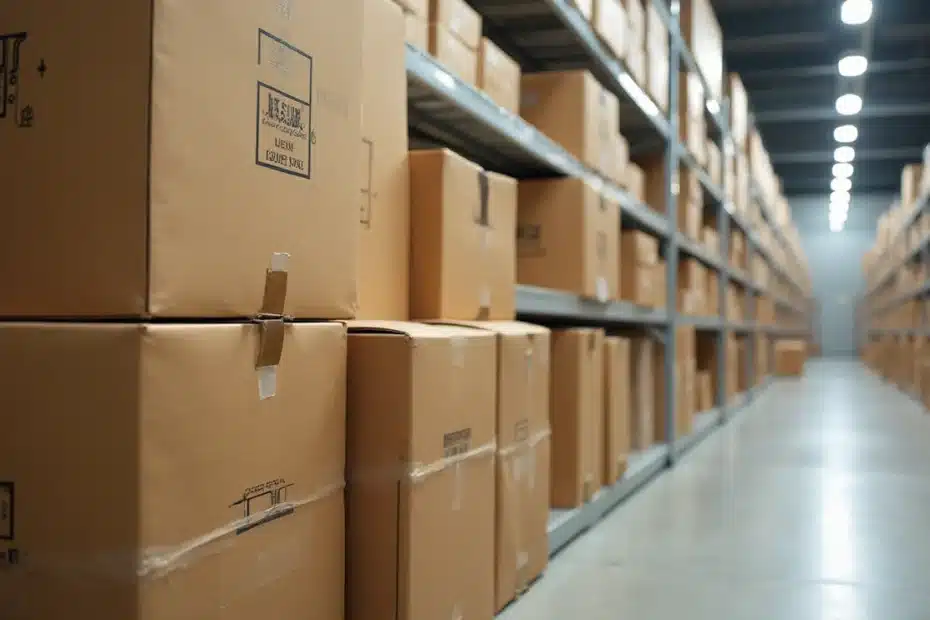Stacking boxes might look easy until you find your storage unit filled with toppled piles and damaged items. Most of us have made this mistake – rushing to stack boxes without planning, then feeling frustrated later while trying to get things out.
Weight distribution plays a vital role in keeping box stacks stable. The quickest way to stack starts with heavy boxes at the bottom and lighter ones on top, which protects valuable items from getting crushed. Box stacks become more stable when you use strong cardboard boxes of the same size that can hold extra weight[-3]. Our team has helped countless customers organize their storage spaces, and we’ve learned that boxes stacked in interlocking patterns stay much more stable. This piece covers everything about smart box stacking, including tips to stack different-sized boxes on a pallet while keeping your items safe.
Choosing the Right Boxes for Safe Stacking
Your secure stack starts with picking the right containers. The strength of your boxes directly determines how much weight they can handle without collapsing.
Why does box strength and size matter
Stacking strength indicates the maximum weight a box can support during its lifetime before it begins to crush. This strength varies based on several significant factors, including the material used, flute size, and environmental conditions. For cardboard boxes, manufacturers test strength through methods like the Edge Crush Test (ECT), which pushes against box edges to measure how well they resist compression.
Boxes stacked in columns spread weight evenly at their strongest points (corners) and keep 100% of their compression strength. However, interlocking your boxes can reduce their load strength by half if you don’t do it correctly. Environmental factors like humidity can reduce stacking strength by 32%. Poor weight distribution also takes a toll on how long your boxes last.
Benefits of using uniform boxes
Boxes of the same size create neater, more stable stacks because there are no gaps between containers. These matching dimensions let boxes stack perfectly edge-to-edge, which stops them from sliding during transport and uses space better.
Similar boxes make organization easier with standard labeling systems. They also help you pack trucks and vans more quickly. Using boxes of the same size leaves less wasted space between containers and lets you store more vertically.
When to use plastic bins vs cardboard boxes
Plastic bins protect your items better than cardboard against physical damage. Their solid structure guards contents from impacts and crushing forces. These containers also keep water out effectively, which makes them perfect for damp spaces or rainy weather.
Cardboard boxes are cheaper, and you might even get them free. You can fold them flat when empty, so they take up little storage space. These boxes usually come in standard sizes, no matter where you buy them.
Plastic bins are a great way to get the most value for long-term storage because they are durable and stackable, keeping your items safe over time. But cardboard works best for temporary storage, especially if you’re moving things you’ll unpack quickly.
Packing Techniques That Prevent Damage

The right containers and proper packing techniques go hand in hand to create secure box stacks. Your valuable items could get damaged if a cardboard box collapses, no matter how sturdy it seems.
How to fill boxes to avoid collapse
Proper weight distribution inside boxes keeps them from failing structurally. Small boxes work best for heavy items, while larger ones suit lighter items. This prevents boxes from getting too heavy or collapsing under their own weight. The heaviest items should always sit at the bottom with lighter ones on top.
Boxes should never bulge from overfilling. A small air gap at the top filled with soft materials will keep items from moving around. The weight needs even distributed evenly inside each container. Make sure the top surface stays flat to stack boxes safely without damage.
Empty spaces make boxes dangerous to pack. Use cushioning materials like bubble wrap, packing peanuts, or crumpled paper to fill all gaps. Items need at least two inches of padding all around to absorb shock and stay put during transit.
Labeling and inventory tips
Pick a labeling system that makes sense to you – color-coding, numbering, or detailed descriptions work well. Put labels on two sides and the top of each box so they stay visible, whatever way the stack faces. Clear packing tape over labels protects them from moisture and handling damage.
A complete inventory system should match your box labels. Here’s what to think over:
- Give each box its number
- Make a master list showing contents and destination rooms
- Take photos of what’s inside before sealing boxes
Mark boxes with fragile items. Write “FRAGILE” or “HANDLE WITH CARE” in bright colors like red or orange on all sides.
Padding fragile items the right way
Each fragile item needs its own bubble wrap or foam padding at least two inches thick. Items must not touch the container walls or each other. Paper stuffed inside hollow areas like bowls or glasses adds extra protection.
Conduct a “drop test” to check your packaging before shipping. Package your items and handle the box roughly to test the protection. Don’t trust “fragile” stickers to protect your items – good interior padding works best to prevent damage.
Stacking Methods for Maximum Stability
Box stacking requires more than just picking the right containers—you need to arrange them carefully to keep them stable when pressure builds up. Your choice of method will dramatically affect how well your stack holds together.
Weight distribution and base building
A strong foundation depends on how well you distribute weight. The heaviest boxes belong at the bottom to build a stable base that won’t crush lighter items. This creates a lower center of gravity, much like a pyramid that stays firmly in place. The storage area needs evenly distributed weight—heavy items concentrated in one spot will strain floors and throw everything off balance.
How to interlock boxes for strength
The two main stacking methods offer different benefits. Column stacking lines up boxes directly on top of each other with aligned corners, which lets them keep 100% of their engineered compression strength. Many people believe interlocking patterns make stacks more stable. In stark contrast to this, the Fiber Box Handbook shows they can reduce stacking strength by up to 50%. This happens because the strongest part of the upper box (corner) sits on the weakest part (side) of the box below.
Avoiding overhangs and unsafe heights
Boxes lose up to 32% of their compression strength when they hang over pallet or shelf edges. A tiny half-inch overhang can slash strength by 20-40%. Height limits matter too—manual stacking must stay under 16 feet, while forklift stacks should stop at 20 feet.
How to stack a pallet with different size boxes
Mixed-size boxes need larger, heavier ones at the bottom for a solid base. Sometimes, smaller but substantially heavier boxes work better as the first layer, with bigger, lighter ones on top. Pyramid shapes put too much strain on the center when stacking different-sized boxes. Brick patterns or pinwheel arrangements help irregularly shaped items stay stable without losing support.
Optimizing Your Storage Layout

Your boxes need a smart storage layout that keeps items accessible and well-preserved, no matter how well you pack them.
Using shelving and vertical space
Smart storage starts with making the most of vertical space. Install sturdy shelving units along walls or in your storage area’s center. Adjustable shelving fits items of different sizes, while wire shelving works best for light objects or spaces that need air circulation to stay dry. Heavy items need commercial metal shelving that delivers extra strength and durability.
Creating walkways for access
A clear path down the middle lets you reach everything in your storage space. Larger units need multiple aisles to help you get to items along the sides. You should leave about 3-4 feet of space between rows.
Placing frequently used items near the front
Stack your boxes based on how often you’ll need them. Keep items you use often close to the front. Your long-term storage items should go toward the back or sides.
Leaving space for airflow and moisture control
Good air circulation stops mold and mildew from growing. Make sure boxes have enough space between and around them. Pallets under your box stacks help air flow underneath.
Conclusion
Box stacking is much more than organizing things neatly—it protects your valuable items from damage and makes the best use of space. This piece explores key techniques that turn messy piles into stable, available storage options.
The foundation of good stacking starts with weight distribution. Heavy boxes need to sit at the bottom, with lighter ones on top. This basic rule stops boxes from crushing each other and keeps everything stable. Your choice of containers plays a huge role in how well your stack holds up. You might pick strong cardboard boxes for short-term storage or tough plastic bins to protect items longer.
The right packing technique makes all the difference. Boxes need proper cushioning to protect delicate items. A good labeling system helps you find specific things without taking everything apart. Column stacking keeps your boxes strong, but many people miss this crucial step.
A well-laid-out storage space ties everything together. A smart organization creates clear paths between stacks. It keeps frequently used items within reach and allows air to flow freely, which stops moisture from building up.
The next time you pack things away, these basic rules will help. Your boxes will stay stable and secure until you need them again. Best of all, you’ll find everything just as you left it—safe and sound. A stack’s success isn’t just about saving space today—it’s about keeping your stuff protected until you need it again.

